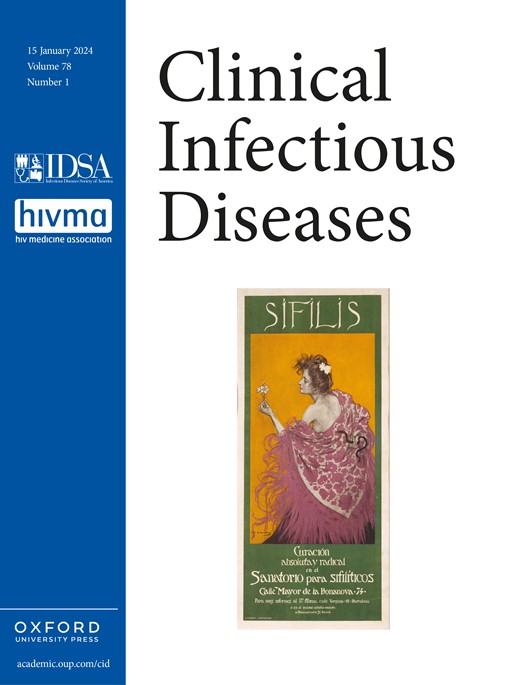无家可归者感染耐多药志贺氏杆菌的严重程度增加
IF 8.2
1区 医学
Q1 IMMUNOLOGY
引用次数: 0
摘要
背景:在温哥华,宋内志贺氏菌在男男性行为者(MSM)中引起了性传播肠道感染。最近,我们发现在无家可归者(PEH)中,耐多药(MDR)子内志贺氏菌菌血症的发病率很高。我们的目的是描述随着时间的推移,S. sonnei 感染的广泛流行病学、临床结果和基因组学。方法 我们对 2015 年至 2022 年间 163 例宋内氏杆菌感染患者进行了回顾性研究。我们收集了两个时期的人口统计学、临床和微生物学数据:历史时期(2015-2020 年)和近期(2021-2022 年)。严重志贺菌病的定义包括住院、菌血症或死亡。进行了全基因组测序,以确定基因型、推断亲缘关系并预测抗菌药耐药性。结果 S. sonnei 感染病例从 8.3 例/年(历史时期)上升到 56.5 例/年(近期)。随着时间的推移,与志贺菌病相关的主要人群特征从 MSM(45.98%)转变为 PEH(86.77%)。MSM 和 PEH 在历史上和近期的人群交叉点相似,分别发生在 3 名(6%)和 10 名(9%)患者身上。与历史时期相比,近期的严重志贺菌病发病率明显更高(69 [61%] 对 7 [14%],p<0.001)。对所有一线和二线药物产生耐药性但对头孢曲松敏感的 MDR S. sonnei 的优势克隆 3.6.1.1.2 (CipR.MSM5)出现了。结论 我们观察到,严重志贺氏杆菌病的发病率大幅上升,从 MSM 通过性传播感染 S. sonnei 转变为 PEH 之间可能的环境传播。PEH中与3.6.1.1.2克隆的MDR S.sonnei相关的更严重疾病可能是受影响人群潜在的脆弱性所致。本文章由计算机程序翻译,如有差异,请以英文原文为准。
Increased severity of multidrug-resistant Shigella sonnei infections in people experiencing homelessness
Background Shigella sonnei has caused sexually transmitted enteric infections in men who have sex with men (MSM) in Vancouver. We recently observed a high rate of multidrug-resistant (MDR) S. sonnei bacteremia among persons experiencing homelessness (PEH). We aim to describe the wider epidemiology, clinical outcomes, and genomics of S. sonnei infections over time. Methods A retrospective review of 163 patients with S. sonnei infections was undertaken from 2015 –2022. We collected demographic, clinical, and microbiological data over two time periods: historical (2015-2020) and recent (2021-2022). Severe shigellosis definition included hospitalization, bacteremia, or death. Whole genome sequencing was performed to identify genotype, infer relatedness, and predict antimicrobial resistance. Results S. sonnei infections rose from 8.3 (historical-period) to 56.5 cases/year (recent-period). Over time, the primary population characteristics associated with shigellosis shifted from MSM (45, 98%) to PEH (86,77%). The population intersection between MSM and PEH historically and recently was similar and occurred in three (6%) and ten (9%) of patients, respectively. Severe shigellosis was significantly higher in the recent compared to historical period (69 [61%] versus 7 [14%], p<0.001). A dominant clone of MDR S. sonnei, 3.6.1.1.2 (CipR.MSM5), emerged with resistance to all first and second-line agents yet with susceptibility to ceftriaxone. Conclusion We observed a substantial increase in severe shigellosis and shift from sexually transmitted S. sonnei infections in MSM to likely environmental transmission among PEH. More severe disease associated with the 3.6.1.1.2 clone of MDR S. sonnei in PEH could be a result of underlying vulnerabilities of the affected population.
求助全文
通过发布文献求助,成功后即可免费获取论文全文。
去求助
来源期刊

Clinical Infectious Diseases
医学-传染病学
CiteScore
25.00
自引率
2.50%
发文量
900
审稿时长
3 months
期刊介绍:
Clinical Infectious Diseases (CID) is dedicated to publishing original research, reviews, guidelines, and perspectives with the potential to reshape clinical practice, providing clinicians with valuable insights for patient care. CID comprehensively addresses the clinical presentation, diagnosis, treatment, and prevention of a wide spectrum of infectious diseases. The journal places a high priority on the assessment of current and innovative treatments, microbiology, immunology, and policies, ensuring relevance to patient care in its commitment to advancing the field of infectious diseases.
 求助内容:
求助内容: 应助结果提醒方式:
应助结果提醒方式:


